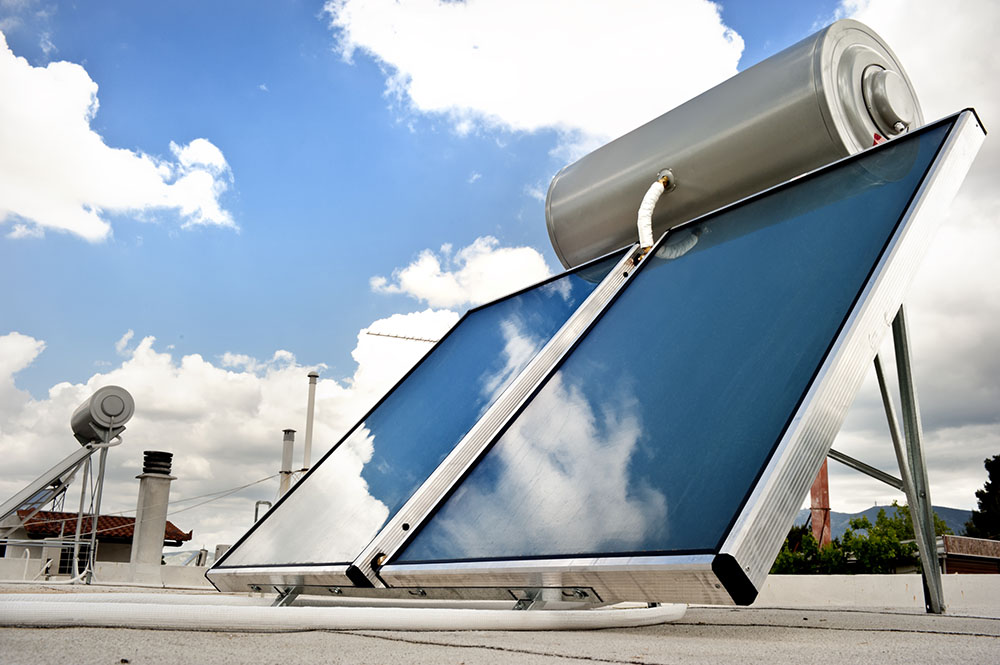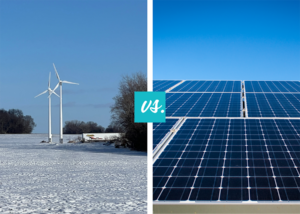Ceres was founded with a mission to create energy-efficient growing spaces that make net zero food production possible. To achieve this, we have designed greenhouses that are highly insulated, use technology that needs very little power (if any), and can be operated using renewable electricity.
Impacts on the agriculture industry, like the natural gas crisis in Europe, affirm the need for greenhouses that can run on renewable energy, and be powered by electricity. Not just for environmental impact, but also for business stability and viability.
In this article we will cover the materials, systems, and technology that make up an energy-efficient, electric greenhouse and provide some guidance on how you can become a more sustainable greenhouse grower.
As a caveat: This article speaks to what is available with greenhouse technology, but each individual project has its own considerations and variables that affect what is possible in the design process. To receive information specific to your location, budget and growing goals, reach out to us directly.
Most Importantly: Energy-Efficient Greenhouse Design
Before we get into the technology of an electric greenhouse, we will start by saying smart design matters. It doesn’t make sense to invest in renewable energy and electric-powered systems and then have a poorly designed or badly constructed greenhouse. That’s a huge energy waste and it doesn’t bode well for your business’ long-term viability. Building features like passive solar design, insulated walls and glazing, and geothermal heating and cooling are going to lessen your electrical demand by a lot.
To learn more about Ceres’ energy-efficient design, check out our other blog, What is an All-Weather Greenhouse?
Replacing Gas-Powered Systems with Electric-Run Systems
Every gas-powered climate control system in a commercial greenhouse has an electric alternative. For example, electric air heaters are very well suited to heat the air in vented greenhouses. Most of these heaters have a thermostat included in the actual heater, so they don’t need to be connected to an external controller. If your farm is making enough renewable energy, using electric air heaters is an excellent (and potentially free) way to heat your greenhouse. Even more efficient than electric air heaters are electric water heaters. Electric water heaters work by circulating water through an electric heater and through a loop through the greenhouse. Alternatively, the heater can heat water that is stored in a hot water storage tank. From there the water can be pumped through a loop in the ground or radiators on the walls or under raised benches. Electric water heaters work well in conjunction with solar thermal systems.
If you are considering a sealed greenhouse solution for your business, there are electric HVAC+D systems available that use heat pump technology to efficiently control the climate of your grow space. For instance, the Ceres EcoLoop™ system is a highly efficient ground coupled heat pump system specially designed for greenhouses and attached buildings. The energy efficient aspects of the EcoLoop™ don’t just stem from heat pumps, but also from the system’s capability to store hot or cold water in the ground (ground coupling). There are many federal and utility based rebates available for ground coupled heat pump systems. Please contact us for more information.

Plants grown in a greenhouse create large amounts of humidity that any HVAC+D (heating, ventilation, air conditioning and dehumidification) system needs to remove. The EcoPack™ is a Ceres designed air to air heat pump system with an extended temperature range that can cool your greenhouse even in very cold and sunny conditions as well as being able to cool the greenhouse when the outside temperatures approach or exceed 120F (50C).

Renewable Energy Sources for Greenhouse Operations
Now that we’ve covered energy-efficient design and climate control systems, let’s discuss the renewable energy systems that make an electric greenhouse a viable option for commercial growers.
Photovoltaic (PV) panels
Commonly referred to as solar panels, PV panels generate electricity every day, but predominantly on sunny days (and mostly between 9 am and 3 pm). Greenhouses, on the other hand, need most of their electricity towards the evenings and nights for supplemental lighting and heating. Therefore, it is most beneficial that you connect your solar panels to the electric grid. When you connect to the grid, you generate electricity when the grid needs it most and you use electricity when the grid has too much (evenings).
If you are not grid tied, you need a way to store energy (see ‘Energy Storage section’ below) to make PV panels useful for your greenhouse. The efficiency of turning solar radiation into electricity via solar PV panels is about 20%. This is because the silicon used in PV systems can’t use as many wavelengths of light as the solar thermal panels (see below), so a lot of the energy from the sun goes to waste. While 20% is not very efficient, PV panels are relatively inexpensive and a good investment to run your greenhouse in a sustainable way. We highly recommend using at least part of your energy supply from solar PV panels to power your electric greenhouse. It is really important to have an efficient design so your PV panels array isn’t too big for your needs.
Solar thermal (hot water) panels
Solar thermal panels are used to collect the sun’s energy during the day and convert that energy into hot water. Most solar thermal systems are connected to a thermally insulated hot water tank, where the hot water can be stored for later use. Most modern thermal solar systems can generate hot water even in very cold (but sunny) climates. Very simple solar thermal systems (drain back type) can be built to heat the water in the storage tank. From the storage tank the hot water can be pumped through tubes in the soil or concrete foundation for radiant heating (usually copper or PEX tubing). Alternatively, the water can be pumped through radiators to heat the greenhouse space. Plants love the warm soil – it keeps the biological activity in the soil high and also minimizes the need to heat the air in the greenhouse. Solar thermal systems convert 60% to 70% of the sun’s energy into heat. Solar thermal systems are therefore one of the most energy efficient methods in converting the sun’s energy into usable heat for heating your greenhouse.

Wind turbines
These days, there are very reasonably priced (and highly subsidized) wind turbines available to power your (all electric) farm that are no bigger than pine trees. The beauty of using windmills to generate power is that the wind is the strongest when the sun is not and when you will need the most amount of energy (at night). Electricity from wind generation is a great way to support your all electric greenhouse.
Wind turbines and solar power are a great combination. Ceres partners with EOCYCLE to provide 2 sizes of wind mills depending on your electricity demand (25kW and 95kW).

Bio-Digesters
Bio-digesting is the process in which bacteria breaks down organic matter (like food and animal waste) in a closed vessel to produce biogas. Biogas can be used for combined heat and power (CHP) operations, or biogas can simply be turned into electricity using a combustion engine, fuel cell, or gas turbine, with the resulting electricity being used on-site or sold onto the electric grid. Bio-Digesters with the associated equipment usually make the most sense for powering larger commercial projects.
Fuel Cells
Fuel cells use chemical energy from fuels (often hydrogen) to efficiently produce electricity. They can be very environmentally friendly as long as the fuel is generated responsibly. Fuel cells can be easily combined with solar panels in off-grid situations where the extra electricity generated during the day can generate hydrogen from water. At night, this stored hydrogen can then be used to create electricity again.
Energy Storage
Batteries
All electric greenhouses, if they are not connected to a reliable grid, need to have a backup system. The most commonly used backup for extra electricity generated during sunny days are batteries. Batteries can give you instant power whenever needed. Sizing a backup battery system correctly is usually best done by professionals and requires knowledge of how much power and energy you will require for a specified period of time. Ceres can also help you select the right system for your needs. For operating an average 3000 sq ft (280m2) vented greenhouse you will need about 400 kWh in battery power per night. It can be as low as 100 kWh in a warm climate without artificial lighting and closer to 600 kWh in a cold climate using electric heater and artificial lighting. Adding a dehumidification system and electric heaters will require significantly more stored energy.
Hot water storage
While hot water storage (ideally in an isolated tank underground) does not provide any electricity, the heat will help keep your greenhouse warm in the winter which decreases the need for additional electric energy. We highly suggest using a hot water tank to heat your greenhouse.
Hydrogen storage
Extra electricity generated on sunny days can be used in electrolysis to generate hydrogen from water. That hydrogen can be stored and then used in a fuel cell at a later time to generate electricity. These systems are very energy efficient but require several important and expensive components. These systems are appropriate for larger (over 20,000 sqft) greenhouse complexes. While the generation of hydrogen is about 70% efficient, the generation of electricity out of hydrogen is about 50% efficient. Together the efficiency of transforming sunlight into electricity via fuel cells is about 35%. While this does not sound like much, the fuel cell process is quite efficient and is almost two times more efficient than obtaining energy from the sun via solar PV panels. As such, this technology can help significantly to reduce your energy cost.
Funding For Energy-Efficient Technologies
If you are considering upgrading to renewable energy systems and energy-efficient technology for your commercial farm, there are funding options available to help offset the upfront costs. For example, the United States Department of Agriculture (USDA) offers the Rural Energy for America Program (REAP), which provides grants and loans to rural businesses and agricultural producers to help them reduce energy costs and invest in renewable energy systems. The program is designed to promote energy efficiency and renewable energy development in rural areas and is available to small businesses and agricultural producers in all 50 states. The program can be used to finance a wide range of renewable energy systems, including solar panels, wind turbines, geothermal systems, and biomass energy systems. It can also be used to finance energy efficiency improvements such as insulation, lighting upgrades, and HVAC improvements.
At Ceres, we are here to help you at every stage of your greenhouse planning process. If you’d like to get in touch with a greenhouse expert to discuss what electric-run systems and sustainable solutions are possible for your specific project, contact us today!












